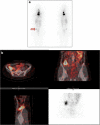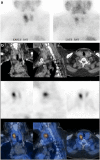Two decades of SPECT/CT - the coming of age of a technology: An updated review of literature evidence
- PMID: 31273437
- PMCID: PMC6667427
- DOI: 10.1007/s00259-019-04404-6
Two decades of SPECT/CT - the coming of age of a technology: An updated review of literature evidence
Abstract
Purpose: Single-photon emission computed tomography (SPECT) combined with computed tomography (CT) was introduced as a hybrid SPECT/CT imaging modality two decades ago. The main advantage of SPECT/CT is the increased specificity achieved through a more precise localization and characterization of functional findings. The improved diagnostic accuracy is also associated with greater diagnostic confidence and better inter-specialty communication.
Methods: This review presents a critical assessment of the relevant literature published so far on the role of SPECT/CT in a variety of clinical conditions. It also includes an update on the established evidence demonstrating both the advantages and limitations of this modality.
Conclusions: For the majority of applications, SPECT/CT should be a routine imaging technique, fully integrated into the clinical decision-making process, including oncology, endocrinology, orthopaedics, paediatrics, and cardiology. Large-scale prospective studies are lacking, however, on the use of SPECT/CT in certain clinical domains such as neurology and lung disorders. The review also presents data on the complementary role of SPECT/CT with other imaging modalities and a comparative analysis, where available.
Keywords: Cardiopulmonary; Endocrinology; Infection; Oncology; Orthopaedics; Paediatrics; SPECT/CT.
Conflict of interest statement
Ora Israel: consultant for GE Healthcare
Gopinath Gnanasegaran: symposia attendance support, Norgine Radiopharmaceuticals
Torsten Kuwert: speaker honoraria, Siemens Healthineers and Sanofi; institutional research grant, Siemens Healthineers; institutional material support, Progenics
Christian la Fougère: consultant, speaker honoraria, research grant, GE Healthcare; research grants, Siemens Healthineers; consultant for Bayer
Samia Massalha: Tucker Research Fellowship award, University of Ottawa Heart Institute
Olivier Pellet, Lorenzo Biassoni, Diego De Palma, Enrique Estrada-Lobato, Giuliano Mariani, Diana Paez D and Francesco Giammarile have no conflicts of interest to declare
Figures













References
-
- Alavi A, Basu S. Planar and SPECT imaging in the era of PET and PET–CT: can it survive the test of time? Eur J Nucl Med Mol Imaging. 2008;35:1554. - PubMed
-
- Mariani G, Strauss HW. Positron emission and single-photon emission imaging: synergy rather than competition. Eur J Nucl Med Mol Imaging. 2011;38:1189–1190. - PubMed
-
- Bischof Delaloye A, Carrió I, Cuocolo A, Knapp W, Gourtsoyiannis N, McCall I, et al. White paper of the European Association of Nuclear Medicine (EANM) and the European Society of Radiology (ESR) on multimodality imaging. Eur J Nucl Med Mol Imaging. 2007;34:1147–1151. - PubMed
-
- Kashyap R, Dondi M, Paez D, Mariani G, editors. Hybrid imaging worldwide—challenges and opportunities for the developing world: a report of a technical meeting organized by IAEA. Semin Nucl Med. 2013;43:208–23. - PubMed
-
- Mariani G, Bruselli L, Kuwert T, Kim EE, Flotats A, Israel O, et al. A review on the clinical uses of SPECT/CT. Eur J Nucl Med Mol Imaging. 2010;37:1959–1985. - PubMed
Publication types
MeSH terms
Grants and funding
LinkOut - more resources
Full Text Sources
Other Literature Sources
Molecular Biology Databases

